Some flowers are more difficult to deal with than others. They may be hard to hydrate, particular about the time of day for harvest, or have an ideal harvest stage. We have eliminated some flowers that are overly difficult, such as basil and euphorbia, but there are some that we just can’t live without, so have learned to deal with their pickiness. We are also updating our post harvest care each year based on efficiencies and systems that are developed.
Start the day with harvest
Our days are organized so that we always start with harvesting flowers. Even during our busiest season, our goal is to get harvest done before lunch, which is at 12:30 p.m. each day. We begin with the flowers that need to be harvested in the morning. We send a crew member into the greenhouses to harvest scented geraniums or dusty miller, and we send someone into the field to harvest crops that need to be harvested while it’s cool. Both of those harvesters will bring their flowers to the barn and put them directly into the cooler so they can chill while we finish the harvest.
Below: The open lilies would be used only for farmers market bouquets, but all the others are at prime picking stage with the buds nice and swollen, just about to crack open. This is the Oriental lily 'Shocking.'
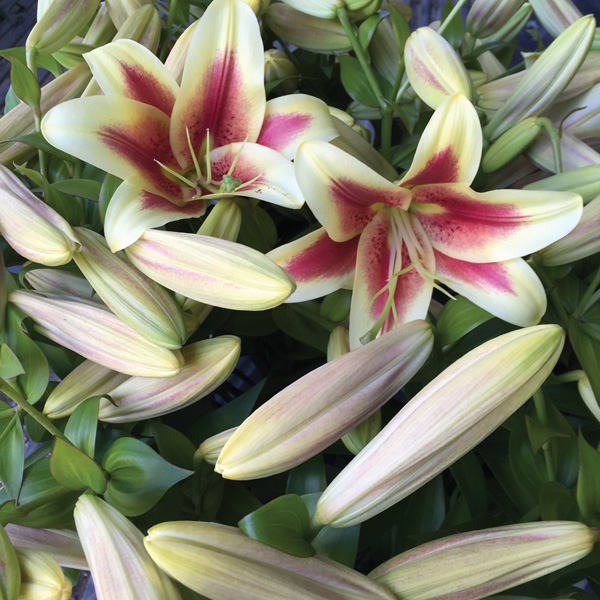
Ensure flowers are hydrated
The field crops that we pick early include yarrow, cynoglossum, and rudbeckia — things that wilt quickly if we are trying to harvest a whole armload. We used to include ammi in that list, but with the Daucus carota ‘Dara’, we’ve found we don’t really need to cut early because the stem is so turgid naturally.
This “early stuff” is left in the cooler until processing time and because it has had a chance to hydrate, it can sit on the table without wilting while we are bunching or making bouquets. If flowers wilt and then get put into the cooler, the stem is going to harden with a wilted look. Even if the flower will pull through, the customer may not buy it.
These difficult-to-hydrate crops are put into Chrysal OVB, which is a flower hydrator. Its main purpose is to open up the cells so the flowers can quickly take up water, all the way to the tip. This product is useful also for woody material that is difficult to keep hydrated. The crops don’t remain in this solution for long, ideally around four hours, according to the label.
If dusty miller or scented geraniums are bunched for florists and delivered the next day, we usually leave them in hydrator because it is one less bucket to wash, but we don’t do that with any flowering crops. We have done that a few times to test it out, and some flowers will over-hydrate and get floppy stems, and others may brown at the tips of the petals. We used to use hydrator for everything except sunflowers, lilies, and zinnias, but this year we are reevaluating and plan to use it only on what really needs it. Our hope is to save money on product, and also save time switching buckets and washing the extra buckets. We’ll see how it goes.
#1 flower killer: dirty water
All finished product goes into Chrysal #2 which is a holding solution. The exact ingredients are proprietary, but we have been told it is mainly glucose for flower food, and citric acid that decreases pH, but also acts as a bactericide in the water. The number-one thing that kills flowers the fastest is dirty water full of bacteria. If your product is going to sit in the same bucket, which is what happens at most grocery stores, it needs as much help as it can get.
We try to educate our supermarket customers to get a fresh bucket and change the water instead of combining buckets. We also encourage them to also use Chrysal #2. Heinen’s, our big distribution center account, started using post harvest products and did some education about flower care with sales associates, and noticed a big difference in flower longevity. If only all our accounts were that receptive to our suggestions!
!For more on which flowers do better with or without a preservative, read the article Floral preservatives vs. water: Research shows which is best.
When washing buckets, we don’t use a scrub brush as it can leave scratches in the plastic and places for bacteria to hide. We just use old towels and have a three bay sink where we wash with soap, rinse with plain water, and then sanitize. In the past we have used Green Shield for sanitizing, but this year are switching to SaniDate since it is OMRI approved. All buckets get washed between every use, so bucket washing is a task that is done 1-2 times a week depending on the volume of flowers we are selling.
Special handling for zinnias
At this point, the only thing we grow that doesn’t go in the cooler is zinnia bunches. If there are zinnias in the bouquets, they go in the cooler; we just don’t intentionally refrigerate zinnias. Zinnias will break your heart because they sell well, but they are really particular about post harvest handling, and sometimes you get premature zinnia meltdown. We always seem to have an issue with vase life in the spring, but I think we have it figured out now.
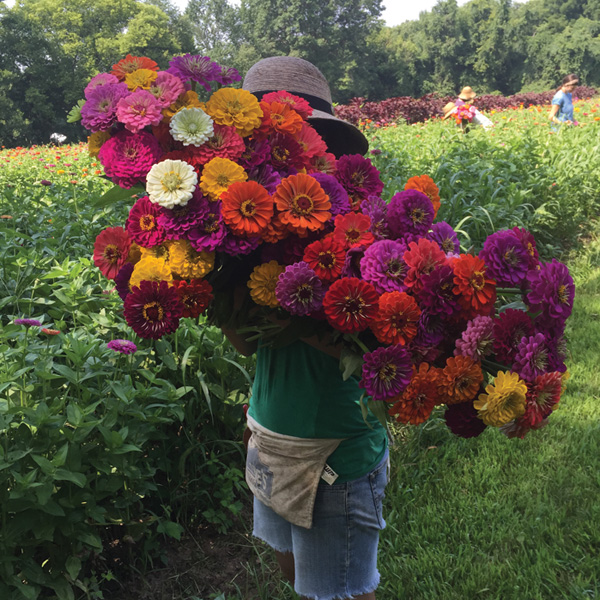
Our water has a high pH and lots of minerals, which zinnias are not fond of. We use the Chrysal #2 solution in our buckets since it decreases pH, but we also use a CVBN tablet in the bucket. This tablet is a slow release chlorine tablet, basically turning our well water into something more like city water. These two items together may seem like overkill, but it is what we have to do to avoid problems with zinnias.
Stage of harvest is tricky, and zinnias probably take the most training of any flower on our farm. Zinnias are a composite flower, which have ray flowers (the petals) and disk flowers (the center of the flower). We harvest just when the little florets start to bloom around the center of the flower, when the stigmas have started to come out of the disk flowers.
If the yellow ring has started to move up the center of the bloom, we don’t harvest it. The ray flowers will be mainly unfurled, although a few may remain curled up in the center of the flower depending on variety. We also want the stems to be turgid. Floppy necks won’t get any better after they are harvested, so we give it a little tap with our snippers before we decide whether or not to cut it.
After cutting, all leaves on the bottom 2/3 of the plant are stripped before placing them in an armload. We deadhead any unusable stems as we are going through the field. That way we don’t have to make a decision again the next time we are going through the zinnia patch. After the zinnias get bunched for grocers or markets, they get put into a fresh bucket with #2 and a CVBN tablet. Zinnias are a very dirty flower, so they are worth getting two buckets dirty to ensure a longer vase life.
Flowers that need to be harvested daily
Sunflowers and lilies are harvested every day to ensure they are taken out of the field at the right level of maturity. We try to have our Saturday crew harvest hard enough that Steve and I don’t have to harvest on Sunday, but occasionally they all blow up at once and Sunday harvest is unavoidable. Sunflowers we have found do best harvested into plain water, and they get stored that way too.
We have one person go through the sunflower patch with gloves on and strip the leaves off the ones that are ready to harvest. We want to get them as the first petal is starting to unfold, before they have fully opened. Then the second harvester follows behind using a broccoli knife to harvest them.
It is just a quick flip of the wrist to cut through the stem, with our goal length about 32” so they can fit into a 5- or 6-gallon bucket. The picturesque field of sunflowers with open blooms that photographers want is not what a flower grower wants to see, because that means you left a lot of money in the field (or you are producing sunflowers for seed and oil).
Lilies get harvested right before the first bloom is about to open. They are harder to transport through the whole process and have lots of opportunities to get damaged if the bloom is open. If the lily is closed when we pick it and sell it, that means it is going to last the duration of the bouquet’s life. Our customers enjoy the bouquet changing through the week as the lily opens.
If there is a bloom cracking open, we use that in a bouquet, but if it is beyond that level of openness, we cut it off before arranging. All lilies are put into buckets with a Bulb T-bag in it, another Chrysal product. It is similar to the #2, except it has a little more flower food in it since the lilies potentially get stored longer. This also helps keep the foliage green when those tighter lily buds start to open.
This may seem like a lot of post harvest procedures, but this is what we have found works for us to ensure maximum vase life. If you are certified organic, check with your certifier before using these products since their blends are proprietary.
You need cooler space
Beginning growers ask me whether they need a cooler and I tell them that I think a cooler is a necessity for a flower farm. It allows you to harvest flowers to store for use the next day, but it also helps slow the maturation of the flower. Once a flower is harvested from the plant, it’s going to die because you’ve cut off it’s life line, but there are measures you can take to slow down that process and get the most vase life out of your products. That doesn’t necessarily mean you need your own cooler right away- maybe someone has space you can rent- but you will have to transport flowers. That’s what we did our first year.
After growing tired of a 20-minute drive to the cooler we were using daily, we built our own cooler with a CoolBot, a device that turns a window air conditioner into a refrigeration unit that can cool our space down to 34 degrees. It is cheaper to use a window AC than it is to use a commercial condenser. Even as our farm grows (we now have a 12’x 20’ space), we still run it with the CoolBot, but now it requires two of them. You can either frame out and insulate a cooler yourself, or buy an existing shell with insulated walls; we’ve done both. To purchase the shell of one used, you can check with Fast Track Auctions or a similar company that sells used equipment from closing businesses.
For more on postharvest handling and growing cut flowers, check out the book The Flower Farmer by Growing for Market Magazine founder Lynn Byczynski.
Gretel and Steve Adams own Sunny Meadows Flower Farm in Columbus, Ohio, sunnymeadowsflowerfarm.com.

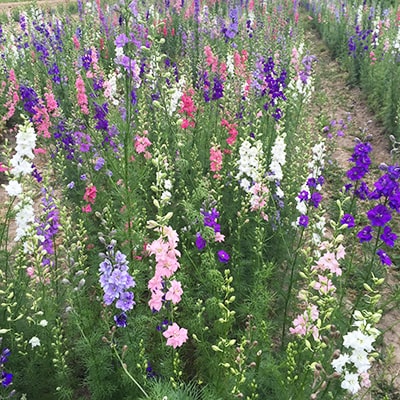
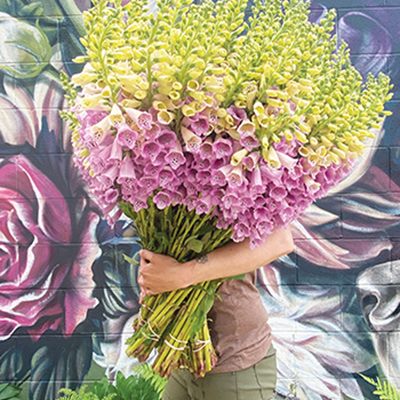
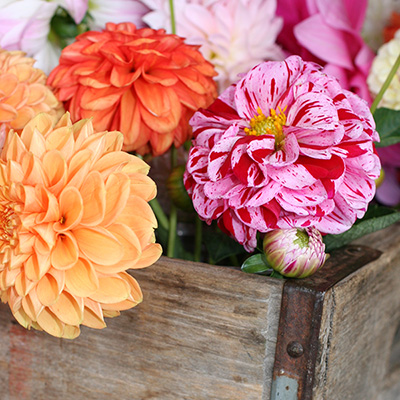


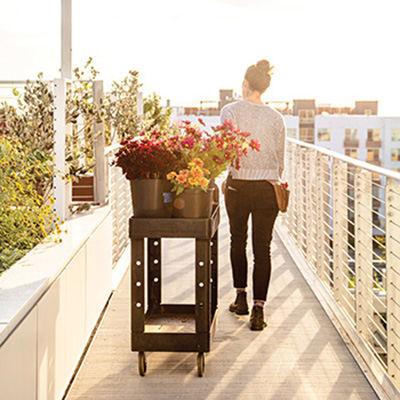
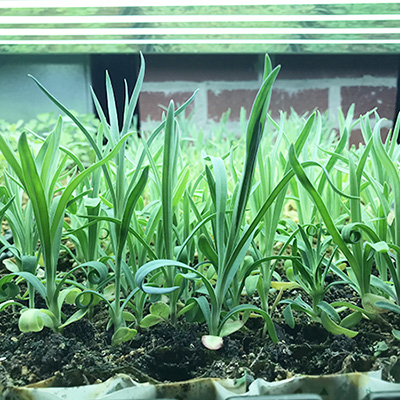
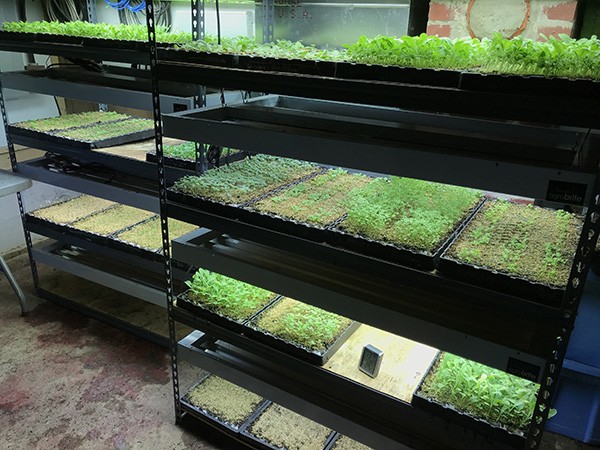 Have you ever lost precious seedlings in your greenhouse to frost? How about tossing a flat or two out due to heat stress or a missed watering? Or better still, stared at a tray of seeds that won’t germinate, with smoke coming out of your ears, because you’re sure someone (not you!) mis-watered them at a critical moment? Have you ever shrugged to yourself reading the growing instructions on a seed packet that says “Germinates best at 70 Fahrenheit” while standing in your 85-90 degree greenhouse? You’ve started to look into a germination chamber to solve some of these issues, but they look pricey and have limitations like not being able to handle as many flats as you’d like to start at once.
Have you ever lost precious seedlings in your greenhouse to frost? How about tossing a flat or two out due to heat stress or a missed watering? Or better still, stared at a tray of seeds that won’t germinate, with smoke coming out of your ears, because you’re sure someone (not you!) mis-watered them at a critical moment? Have you ever shrugged to yourself reading the growing instructions on a seed packet that says “Germinates best at 70 Fahrenheit” while standing in your 85-90 degree greenhouse? You’ve started to look into a germination chamber to solve some of these issues, but they look pricey and have limitations like not being able to handle as many flats as you’d like to start at once.

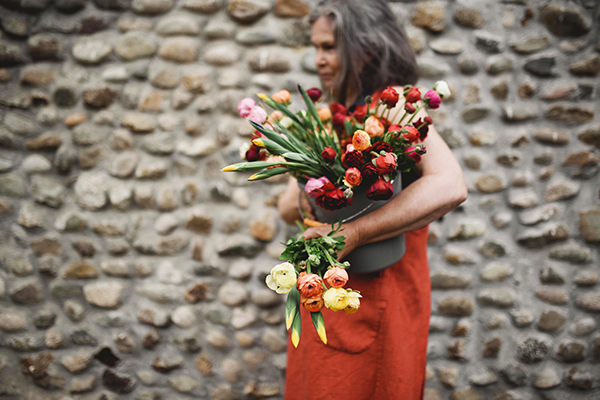 Lorna Jackson started flower farming intensely relatively later in life at Ninebark Farm on a century-old hayfield in Metchosin at the southern tip of Vancouver Island in British Columbia, Canada. Now 64, she plans to continue into her 70s. To keep going, she makes adaptations to ease the toll on her body.
Lorna Jackson started flower farming intensely relatively later in life at Ninebark Farm on a century-old hayfield in Metchosin at the southern tip of Vancouver Island in British Columbia, Canada. Now 64, she plans to continue into her 70s. To keep going, she makes adaptations to ease the toll on her body.
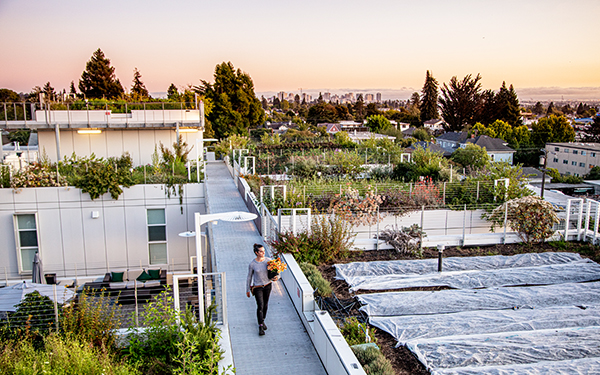 I own and operate Bluma Flower Farm, currently located on a rooftop in downtown Berkeley, California. Going into this year my plan was to try to replicate what I did the year before, one of Bluma’s best years yet. This would have been the first year I didn’t make any big changes. But then the pandemic hit and, of course, like many other businesses, I had to pivot and find ways to survive.
I own and operate Bluma Flower Farm, currently located on a rooftop in downtown Berkeley, California. Going into this year my plan was to try to replicate what I did the year before, one of Bluma’s best years yet. This would have been the first year I didn’t make any big changes. But then the pandemic hit and, of course, like many other businesses, I had to pivot and find ways to survive. 
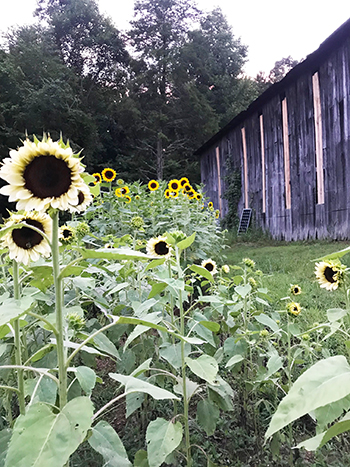 After spending years working in a corporate environment and managing key performance indicators, I was excited about the prospect of farming without the overhead of data analysis. Gone would be the management by objectives, the need to determine return on investment and other such details on which the corporate world revolves.
After spending years working in a corporate environment and managing key performance indicators, I was excited about the prospect of farming without the overhead of data analysis. Gone would be the management by objectives, the need to determine return on investment and other such details on which the corporate world revolves.
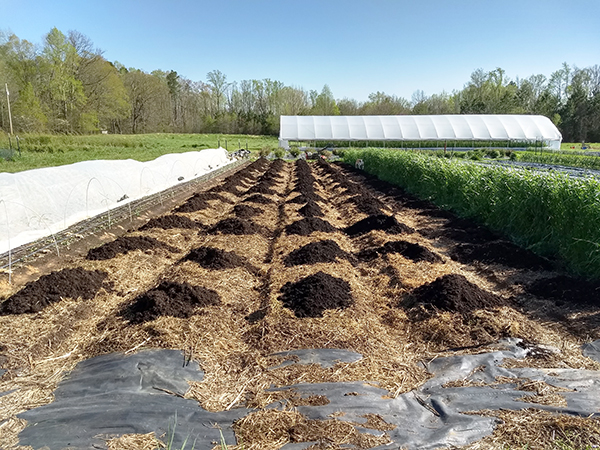 My wife, Megan, and I grow cut flowers on half an acre of a twelve-acre property in Hurdle Mills, NC. We are in the heart of tobacco country. When we bought our property in 2013, our sales contract stipulated that the farmer had the right to harvest that year’s tobacco crop. Based on our best guesses, that marked at least the 100th consecutive year of tobacco/wheat rotations on this property. The farmer was kind enough to disc in the tobacco stubble after the harvest.
My wife, Megan, and I grow cut flowers on half an acre of a twelve-acre property in Hurdle Mills, NC. We are in the heart of tobacco country. When we bought our property in 2013, our sales contract stipulated that the farmer had the right to harvest that year’s tobacco crop. Based on our best guesses, that marked at least the 100th consecutive year of tobacco/wheat rotations on this property. The farmer was kind enough to disc in the tobacco stubble after the harvest.
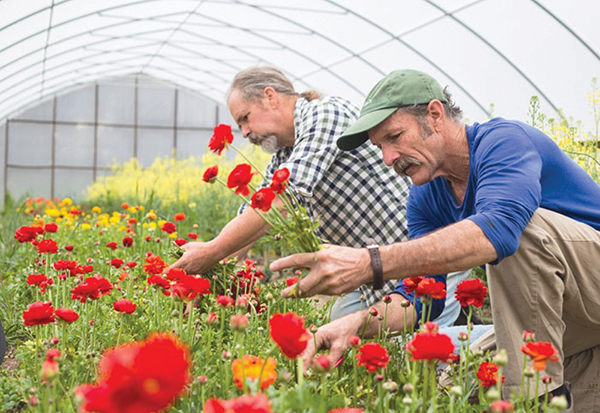 During the COVID era my usual travels have been curtailed. So, I got to thinking about what farms I had visited in the past that I knew pretty well, where a simple phone call could possibly stand-in for a proper on-farm interview and tour. First to my mind was Dripping Springs Garden, an oasis of natural and man-made beauty that is the life’s work of a good friend of mine, Mark Cain, and his farm partner, Michael Crane.
During the COVID era my usual travels have been curtailed. So, I got to thinking about what farms I had visited in the past that I knew pretty well, where a simple phone call could possibly stand-in for a proper on-farm interview and tour. First to my mind was Dripping Springs Garden, an oasis of natural and man-made beauty that is the life’s work of a good friend of mine, Mark Cain, and his farm partner, Michael Crane.
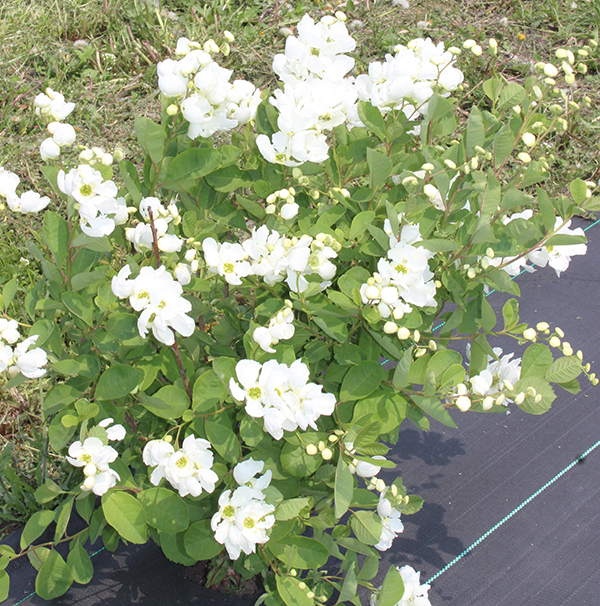 There are a lot of things we can’t grow in our climate and soil here in zone 4a in Starbuck, Minnesota. But I’m especially envious of some of the woody perennials I see other farmers growing – even at farms just a few hours south of us. As a result, I’m always looking for new woodies to try that are hardy here.
There are a lot of things we can’t grow in our climate and soil here in zone 4a in Starbuck, Minnesota. But I’m especially envious of some of the woody perennials I see other farmers growing – even at farms just a few hours south of us. As a result, I’m always looking for new woodies to try that are hardy here. 
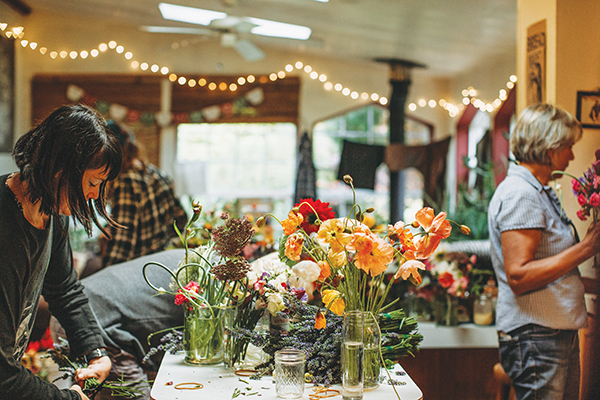 Weddings are a huge opportunity for local flower farmers, especially with the growing awareness of and demand for seasonal, sustainable flowers. And, if there is one time that people really want special flowers, it’s at their weddings.
Weddings are a huge opportunity for local flower farmers, especially with the growing awareness of and demand for seasonal, sustainable flowers. And, if there is one time that people really want special flowers, it’s at their weddings.